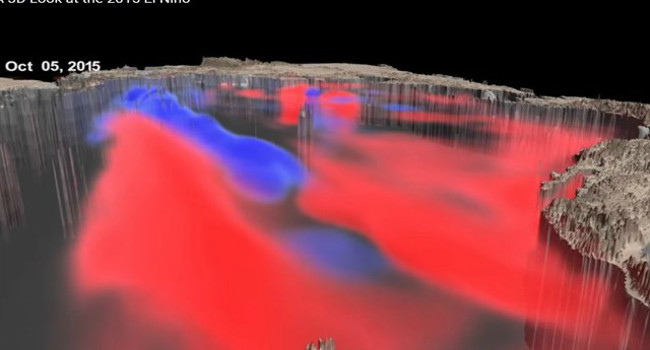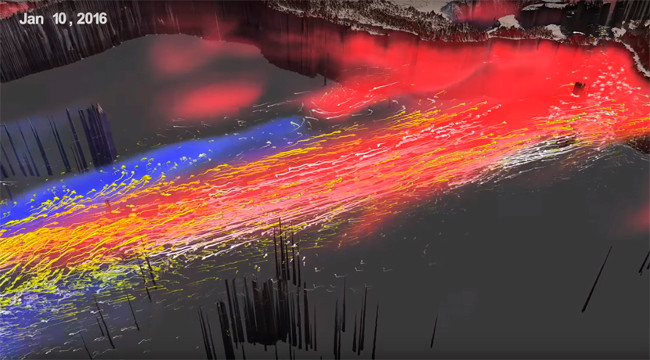NASA announces 3D model of El Nino phenomenon
NASA has released a three-dimensional model of the El Nino phenomenon, a climate model marked with a mass of warm water in the Pacific Ocean.
This dynamic model demonstrates the full life cycle of El Niño, beginning with the formation in January 2015 and ending with dissipation in April 2016.

The model indicates, when winds blow from east to west through the ocean, warm water accumulates in the Western Pacific. When this happens in the East, it makes warm water turn cool and encroach into the ocean surface.
Not only that, El Nino also slows the monsoon or even reverses their direction, pushing the mass of warm water slowly eastward along the equator. Similarly, cooler water moves westward.

The new 3D model shows warm water moving to the east in the summer months of 2015. Finally, cold water moving westward will reach the boundary, stretching out. Once the cool water occupies a much larger amount than warm water, the ocean temperature will decrease, and gradually, the El Nino phenomenon will quickly end.

Both wind currents and sea currents are present during El Nino formation through 3D animation. A series of winds can be seen going east to South America in the El Niño phenomenon, before the normal monsoon winds return in 2016.
You should read it
- Robot Boys help measure the impact of climate change
- The surprising relationship between climate change - birth rate and consequences
- Global warming is killing intestinal bacteria in lizards
- Coral reefs are threatened by ocean acidification, which can disintegrate before 2100
- Climate change is causing the sea to flow faster, scientists are still confused about what the harm will be
- Coral reefs are severely bleached without the impact of El Nino
- Climate change puts bees at risk of extinction, but it's not too late for humanity to save them and save themselves
- Look for evidence of climate change in Antarctica with an iPhone
May be interested
- Google Announces Gemini 2.5 Pro Deep Think, Beats OpenAI's o3 and o4 Models
 at google i/o 2025, google announced a number of updates to its gemini 2.5 model line. the main highlight was the gemini 2.5 pro deep think mode, which is said to beat openai's latest o3 and o4 series models in popular ai benchmarks.
at google i/o 2025, google announced a number of updates to its gemini 2.5 model line. the main highlight was the gemini 2.5 pro deep think mode, which is said to beat openai's latest o3 and o4 series models in popular ai benchmarks. - OpenAI Announces o3 Pro, Its Smartest Reasoning Model Ever
 openai has just officially launched o3-pro, a leading reasoning ai model that uses higher computing power to think deeper and provide answers with superior quality.
openai has just officially launched o3-pro, a leading reasoning ai model that uses higher computing power to think deeper and provide answers with superior quality. - Explore the universe through 5 NASA websites
 as a pioneer in space exploration, nasa has a unique view of the world. we often learn from them more or less.
as a pioneer in space exploration, nasa has a unique view of the world. we often learn from them more or less. - Explaining the mysterious gravity loss phenomenon in some places in Canada?
 some places on canadian territory, especially the hudson bay area, have a mysterious loss of gravity. this phenomenon was discovered in the 60s of the last century that made scientists headache over the years.
some places on canadian territory, especially the hudson bay area, have a mysterious loss of gravity. this phenomenon was discovered in the 60s of the last century that made scientists headache over the years. - NASA announces a place that can survive life right in our solar system
 1 hour this morning, nasa has officially announced the great discovery, enceladus - saturn's moon officially joins places that are likely to exist in the solar system.
1 hour this morning, nasa has officially announced the great discovery, enceladus - saturn's moon officially joins places that are likely to exist in the solar system. - Terrifying hypothesis about the mysterious phenomenon of 'self-igniting' like a fireball
 the phenomenon of self-igniting people is quite familiar to us through famous hollywood movies. in fact this strange phenomenon exists?
the phenomenon of self-igniting people is quite familiar to us through famous hollywood movies. in fact this strange phenomenon exists? - NASA announces more than 1,000 latest Martian surface images
 the reconnaissance satellite (mro) was launched into a satellite orbit in 2005 to study and use hirise cameras to photograph mars. the mro sends photos to earth once a month but this time the photos are very different and unique. the total number of photos is up to 1000 photos.
the reconnaissance satellite (mro) was launched into a satellite orbit in 2005 to study and use hirise cameras to photograph mars. the mro sends photos to earth once a month but this time the photos are very different and unique. the total number of photos is up to 1000 photos. - See the wild magnetic threads NASA found woven into the sun's atmosphere
 scientists from the university of central lancashire in the uk and nasa's marshall space flight center analyzed the data from nasa's high-resolution coronal imager, aka hi-c, mission and discovered the strands.
scientists from the university of central lancashire in the uk and nasa's marshall space flight center analyzed the data from nasa's high-resolution coronal imager, aka hi-c, mission and discovered the strands. - August 21, 2017: NASA will broadcast 360-degree videos directly on Facebook's transcontinental eclipse phenomenon on Facebook, you can see
 on august 21, 2017, the transcontinental solar eclipse will take place in the us and facebook will send an invitation to watch the most spectacular astronomical event of 2017 by nasa to you.
on august 21, 2017, the transcontinental solar eclipse will take place in the us and facebook will send an invitation to watch the most spectacular astronomical event of 2017 by nasa to you. - NASA announced its plan to search for extraterrestrial life
 nasa announces plan to search for extraterrestrial life - phu yen newspaper
nasa announces plan to search for extraterrestrial life - phu yen newspaper










 Fish are encroaching on the sea kelp species
Fish are encroaching on the sea kelp species Scientists decode the genome of the death snail
Scientists decode the genome of the death snail Archeology: Excavating 13 ancient tombs in Tibet
Archeology: Excavating 13 ancient tombs in Tibet WHO revealed an amazing number of people with hepatitis B and C
WHO revealed an amazing number of people with hepatitis B and C The world's first dental fillings are found in Italy
The world's first dental fillings are found in Italy The set portrays the life of poor workers in Hong Kong in the 1990s
The set portrays the life of poor workers in Hong Kong in the 1990s